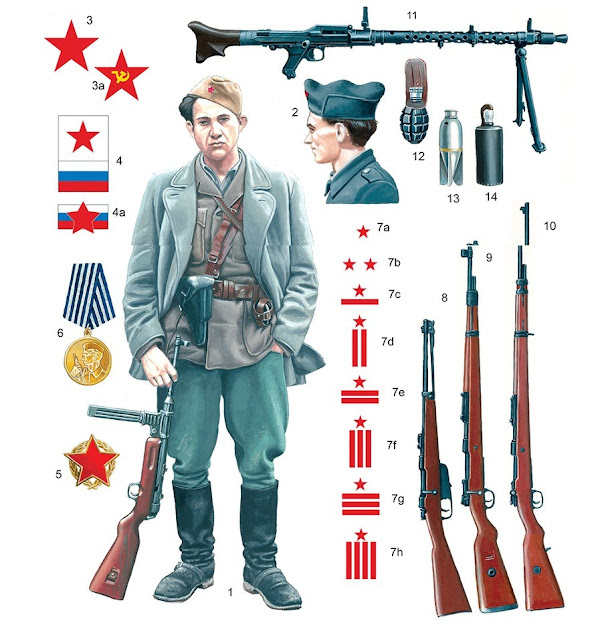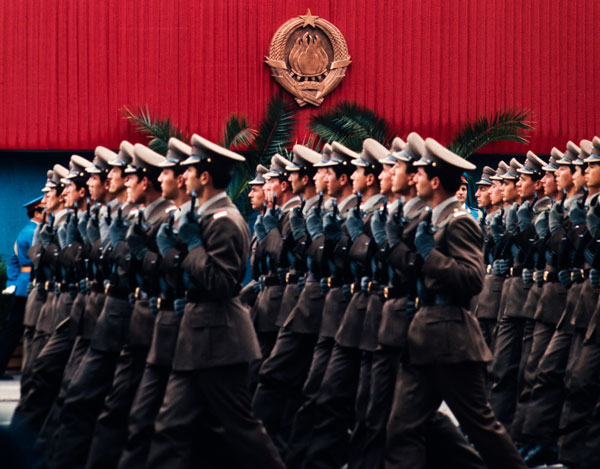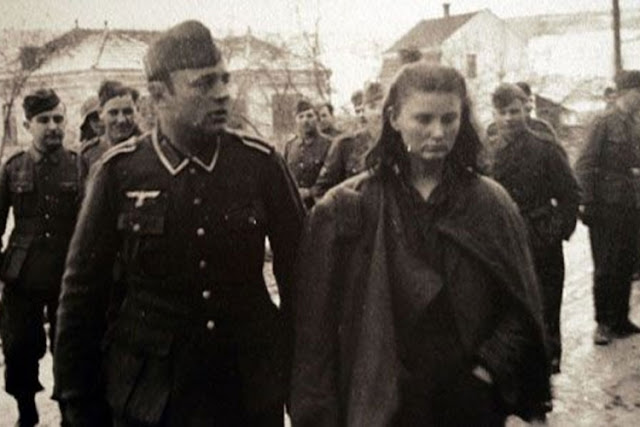Development and modernization of Anti-Aircraft guns and Anti-Aircraft Machine Guns in the Arms of the Yugoslav People's Army
Until the mid-1950s, Yugoslav People's Army units were equipped with air defense equipment of trophy origin, along with air defense equipment of Soviet and American origin. In the mid-fifties, the modernization of the first LPAA LPAA (light anti-aircraft artillery) began, which is most represented in the units of the Yugoslav People's Army. A 20/3 mm PAT license was purchased from the Swiss company Hispano.
At the end of the fifties, a
license for PAT 40 mm L70 with ammunition was purchased from the Swedish
company Bofors. However, that program was abandoned at that time.
As the speed of fighter jets
increased significantly in the early 1960s, the focus of LPAA modernization
shifted to new targets as well as devices to increase the ability to track fast
targets. With old devices, it was simply no longer possible to follow fast
planes, especially in sweeping flights. A mechanical sighting device for AA gun
40 mm M1 was developed, followed by a sighting device of the same type for AA
gun 20/3 M55. The aiming device for the AA gun 37 mm M39 was successfully
reconstructed.
 |
| BOV-3 |
At the end of the sixties, a
four-barrel gun carriage was developed for the needs of defending airports and
air bases, with a suspension for Colt Browning 12.7 mm machine guns.
In the first half of the
seventies, a four-barrel ship's PAT based on the Hispano 20 mm M55 cannon was
developed, with an electro-hydraulic starting device, and in the same period, the development of the 20 mm cannon installation in the BVP M80 turret was
completed.
In order to better protect
infantry units and units of the Territorial Defense, it began in 1969. study
for the development of a single-pipe AA gun 20 mm and since 1975. that gun was
adopted into armaments.
 |
| Detail of 30 mm twin AA gun, vz.5359 |
The development of the ship AA
guns also required the development of a starting device, higher power. The
development of a hydraulic device based on hydrostatic gears from the company
Bofors has begun.
Along with this development, the
Galileo P-36 sighting-computer hydraulic device (our designation J171) for
which a license was purchased was studied and tested.
At the end of the seventies, the
modernization of the purchased Czech AA gun 30/2 mm M53 / 59 was completed with
the installation of the J171 computer-hydraulic device. Immediately afterward,
the development of a laser-computer group for that gun began.
 |
| BVP M80 – SPAT 302 – Foka turret. |
In the 1980s, the introduction of
remote control and coupling with gyrostabilization was investigated. Several
model solutions were realized, first on the ship's AA gun 20/4 mm, and then on
the J171 device.
An electro-hydraulic device for
starting the ship's dome has been developed, and the development of a similar
device with gyroscopic stabilization of a 30 mm gun on the new dome is in
progress.
In the early eighties, the
development of the 40 mm air defense artillery system in self-propelled and
traction versions with a multisensor fire control system began.
In addition to the mentioned
development, the serial production of the 20/3 mm M55 cannon with the Galileo
P-36 target-hydraulic device (under license) was won, and the hull air defense
units were modernized by importing AA gun 57/2 mm, AA gun 30/2 mm M53 / 59 and
AA gun 40 mm L70 Bofors BOFI with laser computer group.
 |
| M-55. |
Ammunition production was won for
all AA guns in the JNA's arsenal. This was done by adopting licenses, but also
by copying samples. The production of the following types of ammunition was
won: instant, instant-flammable, instant marking, armor, armor-marking,
armor-flammable, and armor-marking flammable.
Four-barrel AA gun Colt Browning
12.7 mm
As the American F-84G and F-86E
ended their service life in the Yugoslav Air Force, a large number of Colt
Browning 12.7 mm machine guns remained, with a large amount of ammunition. In
order to use these machine guns for AA defense of stands and infrastructure of
air bases according to the plan of the Air Force and Air Defense, in the period
from 1967 to 1972. a four-barrel AA machine gun on a carriage with a suspension
was developed. The development was carried out by the Military Technical
Institute.
AA gun 20/3 mm M55
Based on the license of the Swiss
company Hispano, the Crvea Zastava Kragujevac Institute produces a three-barrel
AA gun 20/3 mm M55. The Military Technical Institute was in charge of
monitoring production and determining the cause of the machine gun failure. In
the early 1970s. a modification of the 20 mm M55 automatic was adopted. In 1961
the task was set by the Air Defense Administration to modernize that AA gun
through the development of devices for semi-automatic launch. The prototype was
completed in 1967, the zero series in 1974. and serial production began in
1975. The transmission mechanism consists of a mechanical variation of the
friction type and a reducer. Wankel's internal combustion engine is used to
power the device. The installation of the device for semi-automatic starting
increased the efficiency of the cannon by three times.
 |
| Three-barrel gun M55 A4M1 |
Apart from the basic version of
the AA gun 20/3 mm M55 cannon, the following versions of the cannon were
realized by modernization:
- AA gun 20/3 mm M55A2B1 with new
mechanical sighting device,
- AA gun 20/3 mm M55A3B1 which,
in addition to the new sighting device, also has a device for semi-automatic
starting,
- AA gun 20/3 mm M55A4B1 with
Galileo sight-computer-hydraulic device (J171). This version was developed by
the Crvea Zastava from 1969 to 1974.
Self-propelled AA gun 20/3 mm M55A4 - BOV-3
The Air Defense Administration started in 1979. development, whose carrier was the car factory Maribor TAM, together with the Red Flag. The prototype was realized in 1980. and the prototype party in 1982. Production of the zero series began in 1985. The self-propelled AA gun was realized on the upper carriage of the PA cannon 20/3 mm M55A4 and the armored vehicle TAM 150B7 and has the following characteristics:
- weight ... 9400 kg
- maximum vehicle speed ... 93 km / h
- crew ... 4 members
- shooting speed ... 1950 to 2100 met / min
- fire control with Galileo
Single tube top 20/1 mm M55
 |
| BOV-3 anti-aircraft vehicle. |
For AA protection, the infantry unit and the Territorial Defense unit initiated the development of a single-barreled AA gun 20 mm. Two prototypes were made in 1973. The solution of the Red Flag with a three-armed gun carriage was adopted, and already in 1975. the cannon was adopted into armaments.
The basic characteristics of the cannon are field of action in the direction of 3600, elevation from -30 to +830. Maximum angular velocity in the direction of 165 0 / s and in the height of 60 0 / s. The weight of the cannon is 300 kg.
Self-propelled AA gun 30/2 mm
The Red Flag has developed an automatic AA gun of 30 mm for the new turret of the BVP M80 infantry fighting vehicle. Then, the air defense administration gave the task to develop a 30 mm two-barrel self-propelled gun. During 1985 4 cannons were made, which were shown at the Victory Day parade. The characteristics of the cannon are caliber 30 mm, initial projectile speed 1100 m / s, firing speed (2 barrels) 1200 to 1300 m / s, and effective range 2800 m.
 |
| Self-propelled PA top 30 2mm |
Ship AA gun 20/4 mm M75
In 1966 The Administration of the Republic of Macedonia has set a request for the development of a four-barrel cannon based on the 20 mm M55 submachine gun. The bearer of development was VTI KoV. In 1968 a functional model was made. Initially, a request was made for a gyroscopic device to stabilize the platform, which was abandoned. The prototype was completed in 1971. and after that, the prototype party was realized. He was adopted in 1975.
Sources:
www.paluba.info
mycity-military.com
Wikipedia






Comments
Post a Comment